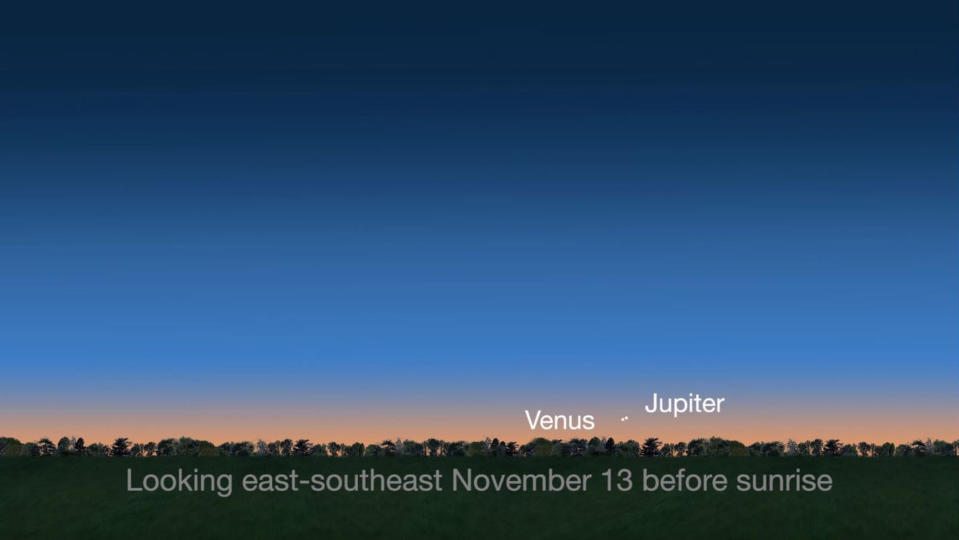Venus and Jupiter Will Meet in the Early Morning Sky Monday: How to See It
Venus and Jupiter will get together in the November sky, and early risers with a clear view of the eastern horizon can catch a view of this celestial rendezvous.
Just before sunrise Monday (Nov. 13), Venus and Jupiter will pass within 17 arc minutes (0.28 degrees) of each other in the sky, or just over half the apparent width of the full moon. The two planets will also be fairly close to each other in the days just ahead of and just after the conjunction.
Two videos released this week explain the conjunction and how to see it. The first is from NASA's Jet Propulsion Laboratory (JPL), and the second is from the Space Telescope Science Institute's (STScI) Hubble Space Telescope website. (STScI serves as NASA's science operations center for the Hubble Space Telescope.) [The 2017 Venus-Jupiter Conjunction: When, Where and How to See It]
The actual conjunction (the point at which the planets are closest together in the sky) will happen at 1:05 a.m. EST (0605 GMT) on Nov. 13. Neither planet will have risen for observers on the U.S. East Coast by then — that won't happen for another few hours, at about 5:30 a.m. EST (1030 GMT). Jupiter and Venus will be in the constellation Virgo, roughly southeast, and west of the moon, which will be a small crescent.

Sunrise will occur mostly between 6:30 a.m. and 6:50 for observers in the continental U.S. according to timeanddate.com; if the horizon is relatively flat, skywatchers can get a good view of the two planets (unobscured by the sun's direct light) until daybreak. For mid-northern-latitude skywatchers, both planets will have an altitude of about 11 degrees above the horizon — or just about the width of a fist at arm's length — when the sun is just below the horizon.
In Los Angeles, the conjunction will be well below the horizon when it occurs, though, on the morning of Nov. 13, Venus and Jupiter will rise at 5:19 a.m. and 5:18 a.m., respectively. Sunrise is 6:24 a.m., and Venus and Jupiter will be slightly higher above the eastern horizon than in New York; Venus' altitude will be 12.5 degrees and Jupiter's 12.7 degrees.
Londoners will see Venus rise at 5:56 a.m. local time, followed by Jupiter 2 minutes later, with the moment of conjunction occurring at 6:05 a.m. The sun rises at 7:15 a.m. local time. The maximum altitude is about 11 degrees above the horizon, which requires a relatively unobstructed eastern view.
In the video from JPL, the narrator notes that skywatchers should be careful because the sun will rise on the heels of the planets, and of course, you should never look directly at the sun, especially with binoculars or a telescope.
The STScI video outlines several other planets that will be visible in November. Saturn will be in the western sky in the evening, along with the zodiac constellations Pisces and Aries. Mars will also rise well before the sun this month.
You can follow Space.com on Twitter @Spacedotcom. We're also on Facebook & Google+.

 Yahoo News
Yahoo News 
